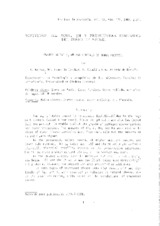Mostrar el registro sencillo del ítem
Actividad del agua, pH y principales minerales del queso de Mahón
| dc.contributor.author | Esteban, M. Asunción | es_ES |
| dc.contributor.author | Marcos, A. | es_ES |
| dc.contributor.author | Beltrán de Heredia, F. | es_ES |
| dc.contributor.author | Alcalá, M. | es_ES |
| dc.date.accessioned | 2010-05-04T10:57:09Z | |
| dc.date.available | 2010-05-04T10:57:09Z | |
| dc.date.issued | 1983 | |
| dc.identifier.issn | 1885-4494 | |
| dc.identifier.uri | http://hdl.handle.net/10396/3140 | |
| dc.description.abstract | The a of Mahón cheese is relatively low (0,93-0,94) due to the high salt content (about 4 per cent). Since th pH value was also low (about 5,0) the poduct is stable against the growth of pathogen microorganisms and toxin productio. The amount of Ca, P, Mg, and Fe werw similar to those of other cheese varieties made fom cow´s milk but the amounts of Na and K werw higher. In the processed, melted cheese, of higher moisture conten and lower salt content, the aw value was 0,97 and the pH value was variable (5,2-5,9). Microbial stability depenos on the preservative additives. Due to lox crude protein coontent the Ca, in the product was poor. In the grates cheese, poor in moisture but rich in salt, the aw was below 90 and the pH value was low (5,1), being also microbiologically stable. However, the product was also protected by additives. In both types of processed cheese very high levels of P and high levels of Na, and K, werw observed in relation to natural heese, due to the phosphate melting salt added in the manufacture of processed cheese. | en |
| dc.description.abstract | El queso de Mahón natural tiene una a w relativamente baja (de 0.93-0.94), debido a su alto contenido salino ( -4 p.100),y un valor pH también bajo (de aproximadamente 5,0) que le confieren estabilidad frente al crecimiento de gérmenes patógenos e inhiben la producción de toxinas. Las cantidades de Ca, P, Mg, Zn y Fe resultan similares a las de otras variedades de queso de vaca, y son comparativamente altas las de Na y K. En el queso fundido en porciones, de mayor contenido acuoso y menor contenido salino, la a w es de 0,97 y el pH altamente variable (5,2-5,9), encontrándose protegido por conservadores. Por su escasa proteTna es relativamente pobre en Ca. En el queso fundido y rallado para gratinar, pobre en agua y rico en sal, la a w es inferior a 0,90, siendo el pH bajo también (5,1), por lo que igualmente resulta muy estable. No obstante, también contiene aditivos conservadores. En ambos tipos de quesos procesados se han observado tasas muy altas de fósforo en comparación con el queso no procesado, as! como altos niveles de Na y K, debido a la adición de fosfatos (principalmente de sodio) como sales fundentes. | es_ES |
| dc.format.mimetype | application/pdf | es_ES |
| dc.language.iso | spa | es_ES |
| dc.publisher | Universidad de Córdoba, Servicio de Publicaciones | es_ES |
| dc.rights | https://creativecommons.org/licenses/by-nc-nd/4.0/ | es_ES |
| dc.source | Archivos de zootecnia 32 (122), 17-31 (1983) | es_ES |
| dc.subject | Queso de Mahón | es_ES |
| dc.subject | Minerales | es_ES |
| dc.subject | Actividad del agua | es_ES |
| dc.subject | pH | es_ES |
| dc.subject | Queso rallado | es_ES |
| dc.subject | Queso fundido | es_ES |
| dc.title | Actividad del agua, pH y principales minerales del queso de Mahón | es_ES |
| dc.title.alternative | Water activity, pH and minerals of Mahón cheese | en |
| dc.type | info:eu-repo/semantics/article | es_ES |
| dc.relation.publisherversion | http://www.uco.es/organiza/servicios/publica/az/az.htm | es_ES |
| dc.rights.accessRights | info:eu-repo/semantics/openAccess | es_ES |

